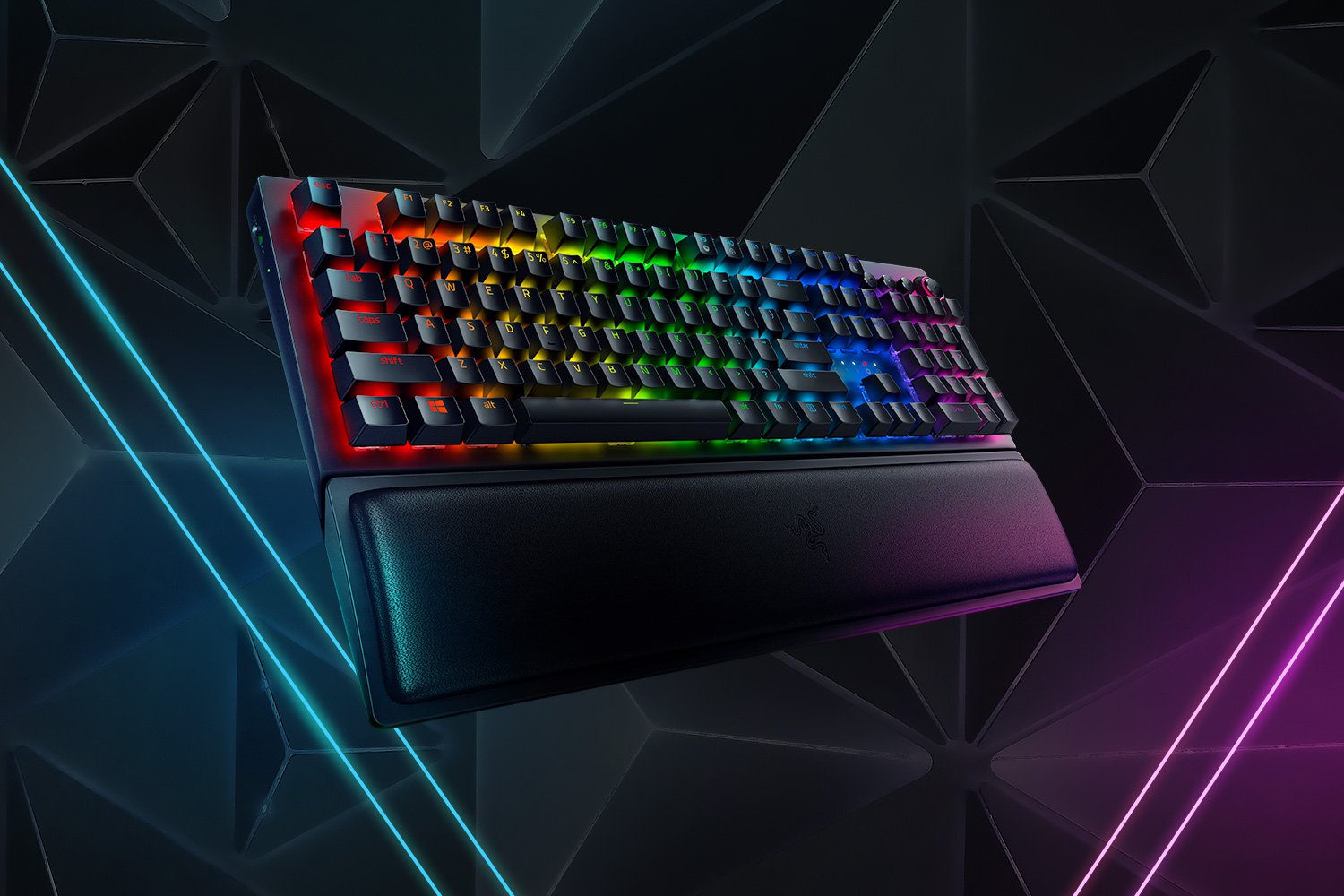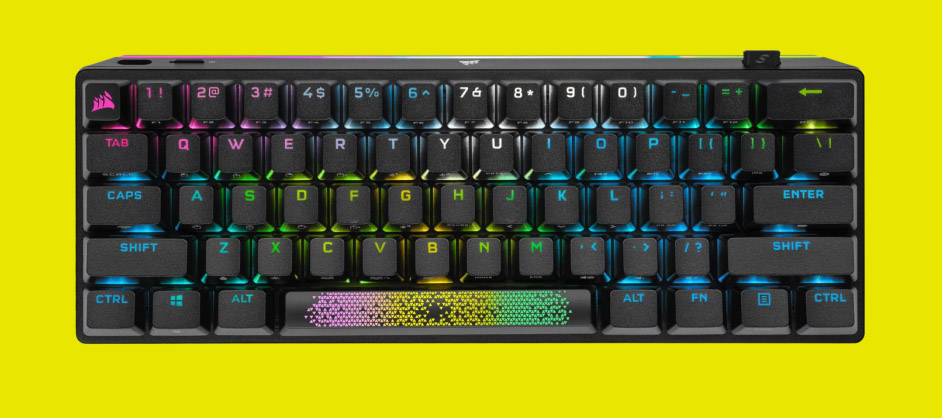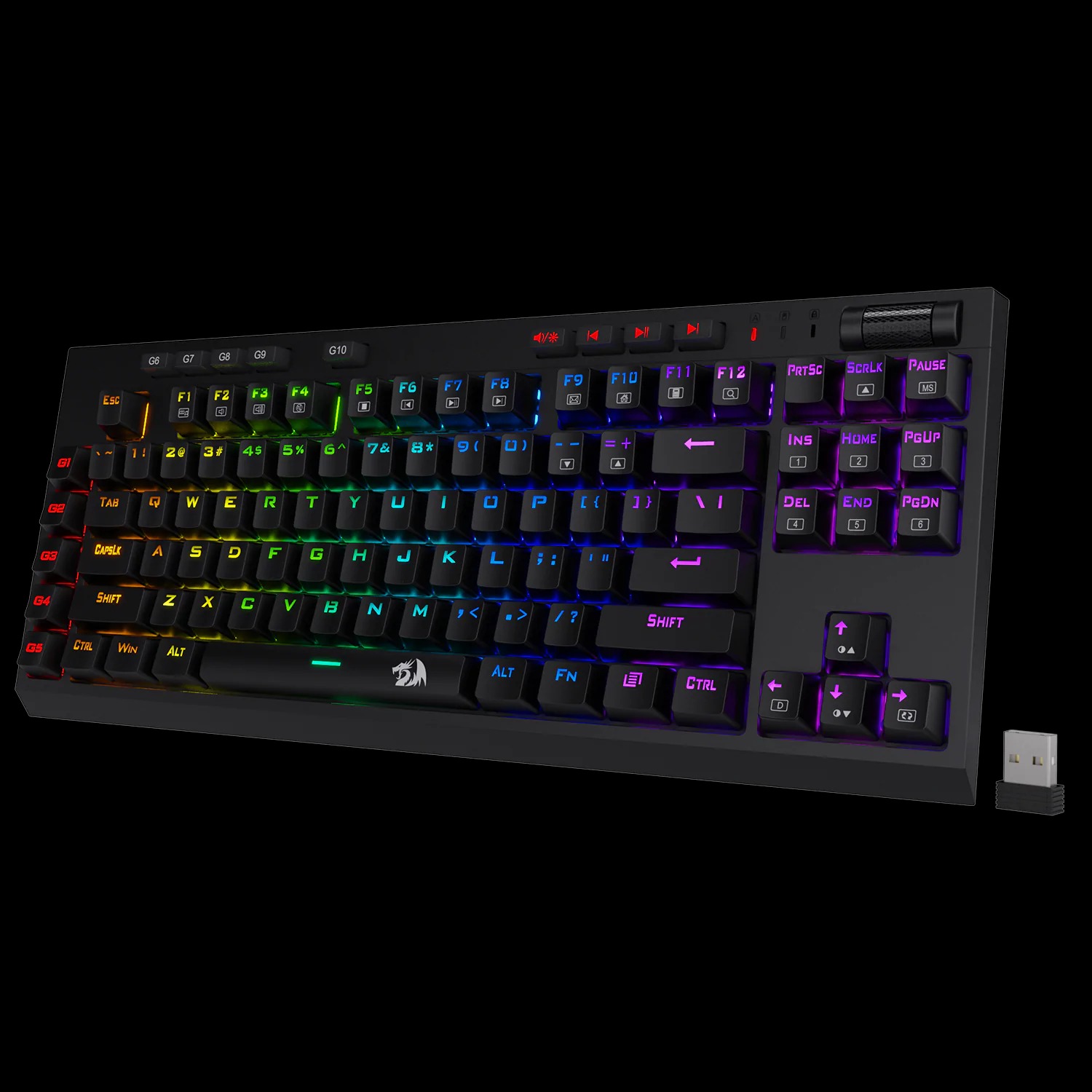While gaming keyboards once demanded to be tethered to a PC for the best performance, new wireless connections are now able to handle the twitchy reflexes of even the fastest gamer. That means it’s time to cut the cord and get yourself a wireless keyboard for a bit of modern creature comfort in your PC gaming setup. You’ll pay a little more—unless you go for a budget option—but it’s a worthwhile upgrade, we promise.
You can use any old keyboard to play PC games, but there’s an additional element to consider when you’re looking for the best wireless gaming keyboard: latency. The Bluetooth connection on a keyboard like the otherwise excellent Keychron Q1 Pro just isn’t up to snuff for the fast-paced world of online shooters and other multiplayer games, so you’ll want something with a dedicated RF connection and a USB-based dongle. This is what truly makes a wireless keyboard a gaming keyboard, more so than fancy lighting or programming options.
We recently reviewed the Asus ROG Azoth, which is an interesting “kitchen sink” case: a keyboard that includes every possible wireless gaming feature and every element of a high-end, boutique mechanical board, with an OLED screen and even an included switch-lubing station. Unfortunately some elements fell short of its sky-high price tag, including an awkward alternative to a radial dial and absolutely abysmal programming options.
For more tips about what to look for in a wireless gaming keyboard, scroll to our buying guide below our list of recommendations.
Razer BlackWidow V3 Pro – Best wireless gaming keyboard overall

Pros
Super-smooth switches
Great media controls
Comfy wrist rest
Cons
Expensive
ABS keycaps are a little cheap
The latest in a long line of high-end keyboards called BlackWidow, this particular model pulls out all the stops. In addition to dual Bluetooth and RF wireless for multi-device connectivity, it comes in a full-size frame with a 10-key area and robust media controls. Razer’s typical light show is on display, but the real star is the switches, high-quality hall-effect designs that come in smooth linear (yellow) or loud and clickly (green) varieties. The package includes a comfy magnetic wrist rest, as it should considering it’s one of the most expensive gaming keyboards on the market.
Read our full
Razer BlackWidow V3 Pro review
Corsair K70 RGB Pro Wireless Mini – Best 60% wireless gaming keyboard

Pros
Amazing list of features
Standard layout and hot-swap switches
Great lighting
Lightweight
Cons
Expensive
Limited programming options
No wrist rest
Price When Reviewed:
171,99 Euro
Those looking for the tiniest gaming keyboard around might have to squint a little to see the diminutive K70 Pro Wireless Mini. This 60% design is as small as mainstream keyboards come while still packing in full high-end functionality, including hot-swappable switches for the ultimate in mechanical customization. (Even though the included “speed silver” switches are already pretty great. The keyboard includes a dazzling light show and both RF and Bluetooth wireless, as well as a secondary space bar for even more bling. Just be aware that you’re paying quite a lot for this board, and that some may find its programming options lacking, especially for a super-small design.
Read our full
Corsair K70 RGB Pro Wireless Mini keyboard review
Razer Deathstalker V2 Pro keyboard – Best low-profile wireless gaming keyboard

Pros
All the features of a big Razer board in a small size
Comfy media controls
Many connection options
Cons
Default mute is a bit tricky
No wrist rest
The Deathstalker V2 Pro is a bit of a throwback for Razer, recalling the days when expensive gaming keyboards were thin and sleek. This one’s still mechanical though, so it has that great typing and gaming feel with a bit less key travel. The big, finger-friendly volume wheel is particularly nice. There are thinner options out there, like the Corsair KIOO Air, but it’s both more expensive and less comfortable. The Deathstalker V2 also comes in a TKL size if you don’t need a num pad.
Read our full
Razer Deathstalker V2 Pro keyboard review
Redragon K596 Wireless Keyboard – Best budget option

Pros
Low price
Included wrist rest
Long battery life
Volume wheel
Cons
Ugly keycaps
Can only program G keys
No Bluetooth
If you need a wireless gaming keyboard for under a C-note, Redragon (pronounced “re-dragon,” maybe, who knows?) is happy to provide. While this model lacks fancy features like multi-device Bluetooth, it includes a few that you wouldn’t expect at this price point, including a volume wheel and an included magnetic wrist rest. It also has a surprising focus on gaming functionality: Custom “G” buttons can be bound to individual functions or macros on the fly. The ABS plastic and branding aren’t exactly gorgeous, but you can use the money you’ve saved to grab some custom keycaps.
Read our full
Redragon K596 Wireless Keyboard review
Asus ROG Falchion Wireless 65% Mechanical Gaming Keyboard – Best wireless gaming keyboard for travel

Pros
Long battery life
Carrying tray
Handy volume touch panel
Cons
RF-only wireless
No USB-C dongle
Poor programming options
The Asus Falchion is another small keyboard, but its inclusion of arrow keys makes it a bit more comfortable and practical than a 60% design. The Falchion has a few touches that make it a superior board for on-the-go gaming, namely the touch-sensetive volume slider on the side and the included protective carrying case. Its RF-only wireless should cut out lag for mobile sessions, though you might need a USB-A-to-C cable (not included) for tablets or phones. The long battery life means you won’t be hunting for a charge when a session breaks out.
Read our full
ASUS ROG Falchion Wireless 65% Mechanical Gaming Keyboard review
Pardon me for being obvious, but wireless keyboard shoppers should care about the same things they would for a regular keyboard…only wireless. Expect to pay a significant premium over wired designs, at least when looking at multiple models from the same category or brand. More personal and subjective features, like the feel of mechanical switches, might necessitate a trip to your local electronics store (or tracking down a handy key switch tester for trying dozens at once).
Wireless options
Gaming keyboards tend to use RF wireless with a USB dongle, instead of a Bluetooth connection, which is more popular with modern “standard” wireless keyboards. That’s because it allows manufacturers to use a more reliable, direct connection, with a higher polling rate—that means the connection between the board and your computer refreshes itself much more often, minimizing input lag. Some advanced models still include Bluetooth, along with fancier options like pairing multiple devices to the same USB dongle. Range typically isn’t a concern if you’re using a keyboard with a gaming desktop, but you might want to think about it if you have a gaming PC hooked up to your TV.
Most high-end wireless gaming keyboards can also use a direct wired USB connection, if you’re worried about wireless interference in a crowded environment.
Key switches
Modern mechanical keyboards come in a staggering array of switch varieties, from smooth and linear to loud and clickly, with tons of options for mechanisms and spring strength. The only real way to know which one you prefer is to try ’em out (retail store displays are great for this). That being said, more expensive keyboards tend to come with nicer, high-quality switches from name brands like Cherry and Gateron. For the ultimate in customization, track down a keyboard with hotswap switches, which let you swap out the switches for new and different ones whenever you want.
Recently more advanced types of switches have emerged, like optical and “laser” switches tripped by interrupting a beam of light, or “mag lev” switches that allow you to adjust the force it takes to activate the key. These are interesting, but tend to lack actual utility (unless you have truly superhuman perception), and increase the price of keyboards phenomenally.
Keycaps
Keycaps are the little pieces of plastic that sit on top of the switches—what your fingers press down on. Switching out the keycaps for a set of nicer ones, maybe made of better PBT plastic or themed after your favorite TV show, is a popular and easy keyboard mod. Some keyboard makers even sell their own upgrade sets. Keycaps with a Cherry MX-compatible stem will work with almost all modern mechanical switches, just make sure you find a set that matches the layout of your keyboard.
Battery life
Unlike gaming mice, battery life generally isn’t a big concern with gaming keyboards. They’re big enough that there’s plenty of space for internal batteries that last for weeks, or even months, between charges. That is, unless you over-use that fancy RGB lighting with dazzling animation…in which case, it might last just a few days or hours. If it’s available, check the milliamp-hour (mAh) rating for the battery.
Layout
The layout of the keys on your keyboard varies more than you might think. Full-sized keyboards include a 10-key area to the right of the arrow cluster, but gaming models often omit this in order to make more room for mouse movements, calling this the “10-key-less” layout. Some keyboards go even smaller, with 60% being the smallest that mainstream brands use, chopping off the Function row, 10-key area, and even the arrow keys (which have to be accessed via a Fn button). A few designs go even larger than the full layout, with an extra column or two of programmable keys for custom bindings or macros. Which one you want comes down to a matter of available space and, perhaps more pertinently, taste.
These general layouts shouldn’t be confused with country- and region-specific key layouts, like ANSI and ISO. Most popular designs are available in at least those two variants.
Lighting
Even budget gaming keyboards come with LED backlights these days, though they might not be the full programable, device-synced light show that companies like Razer and Corsair delight in. Unless you’re constantly playing in the dark and you can’t touch-type, it’s entirely cosmetic. It’s fun, that’s about it.
Keyboard makers are forever trying to one-up each other with extra features. For a mechanical board you can generally expect a removable USB cable (maybe a braided one for nicer boards), and possibly an included keycap puller and wrist rest. Larger boards usually include dedicated media controls, and the nicer ones get a fully programmable wheel or knob. An especially nice option is on-device memory, allowing you to keep key layout programs without running a driver program on each new computer.
>>> Read full article>>>
Copyright for syndicated content belongs to the linked Source : PCWorld – https://www.pcworld.com/article/835195/best-wireless-gaming-keyboards.html































